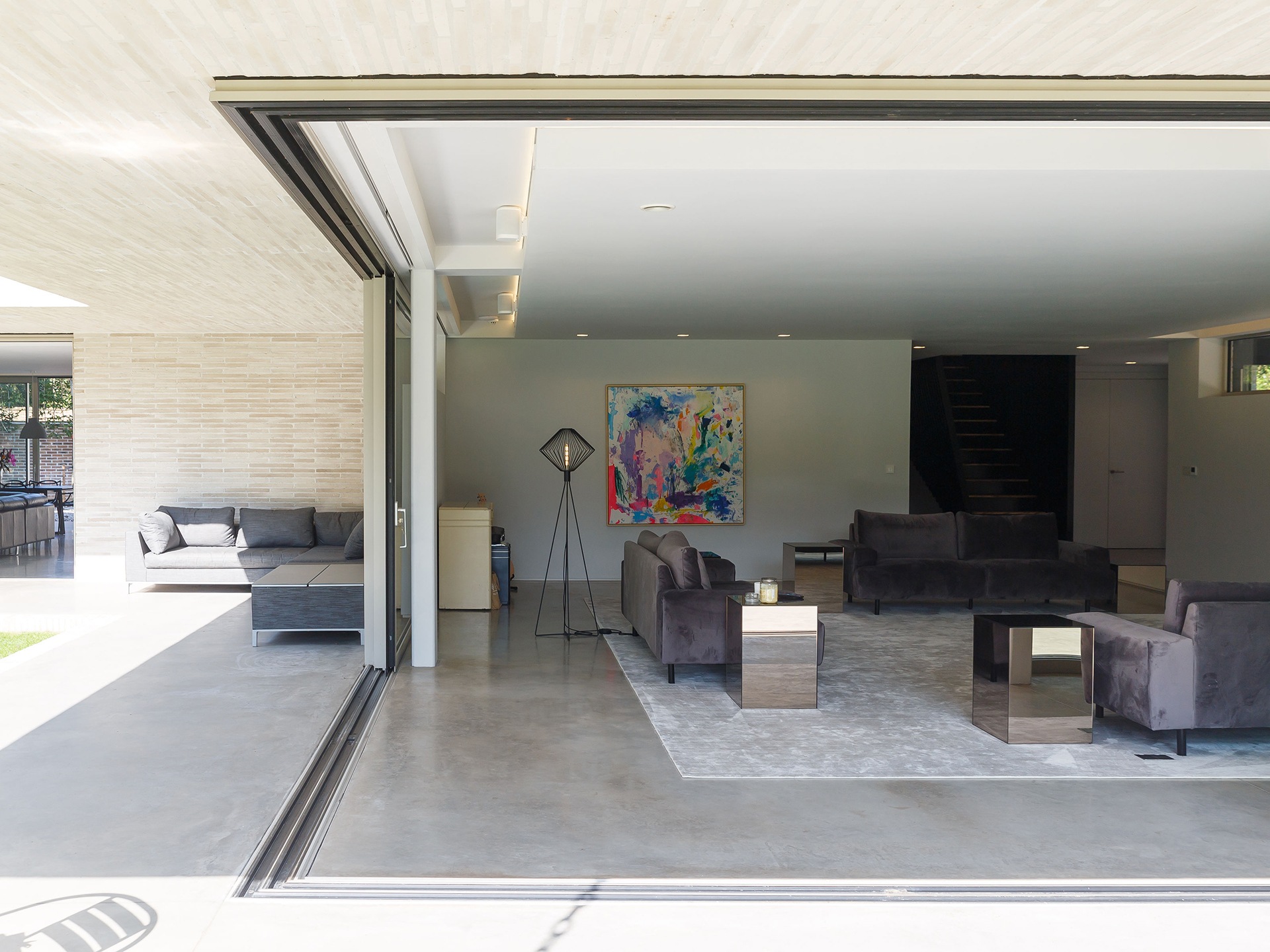Polished concrete flooring guide – price, pros and cons and more
The ultimate in fashionable flooring has come a long way from, well, the factory floor. It now graces the most stylish, high-end of projects, giving that hip, industrial-chic look that is so desirable.
The notion of leaving exposed an element of a building’s structure that was traditionally hidden with carpet or other floor covering has its origins in some of the big aesthetic movements of the last century: in Modernism’s emphasis on ‘truth to materials’ and Brutalism’s love of exposed concrete. But the very first evidence of a polished-concrete floor was actually discovered in an archaeological dig in Jericho, dating back to more than 1200BC. Terrazzo flooring, meanwhile, made from polished cement containing small chips of quartz or marble, has been around since the 19th Century.
The technology to produce today’s glossy polished-concrete floors was developed towards the end of the last century as a means to refurbish floors in industrial settings. But it was soon adopted by architects looking for an industrial feel in minimalist residential projects. And it’s now the flooring of choice for many self-builders. But just how do you achieve the highly desirable polished-concrete look, and what are its pros and cons as a flooring choice? We’ve got all the answers.
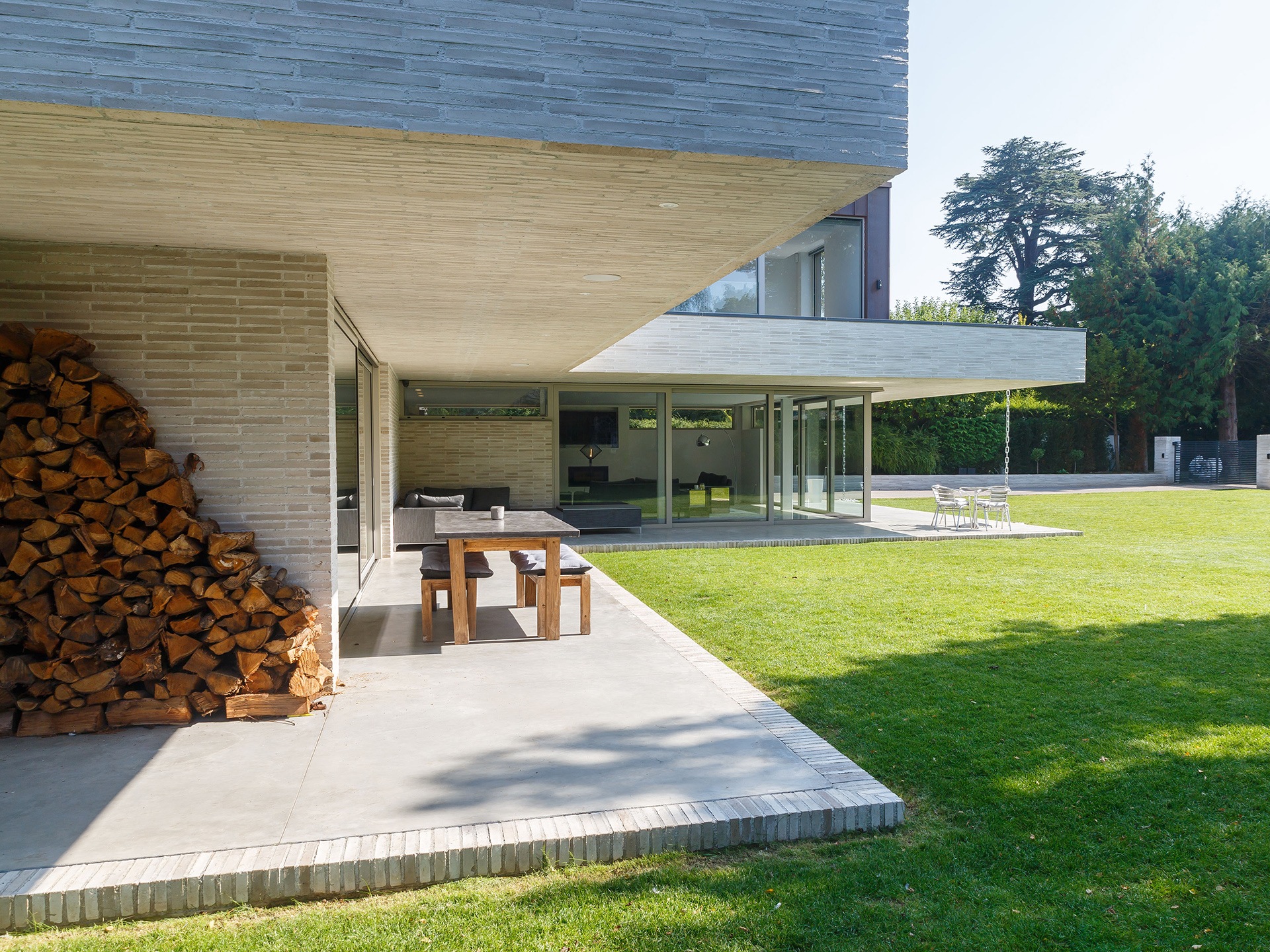
- Seamless indoor–outdoor transition with a light shade of concrete installed by Lazenby
Martin Clark, managing director of Concrete Polishing UK, says, “Polished concrete is a good choice because it’s hard-wearing, low maintenance, efficient with underfloor heating, and has a small carbon footprint, especially when using blended cement. It also comes in a range of colours/styles, and every floor is unique because it is hand-crafted using locally sourced materials. No two floors are ever the same.”
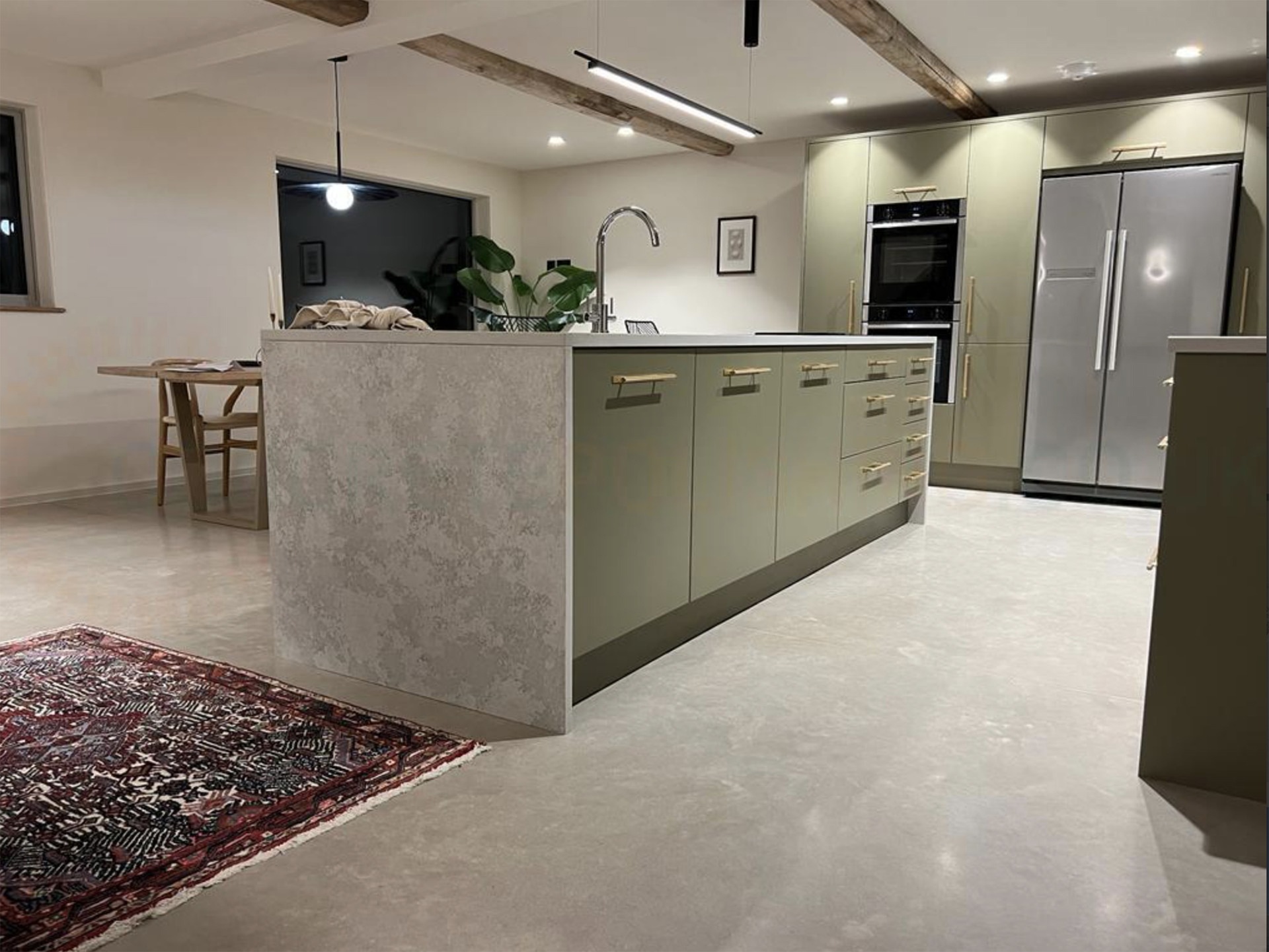
- Rustic-style polished concrete installed by Concrete Polishing UK suits this kitchen perfectly
What is polished concrete?
The polished-concrete look can be achieved in several different ways, each of which is suited to different contexts, and each of which gives a slightly different final finish. Essentially, though, the “polishing” of concrete is the grinding down of its surface with a concrete-grinding machine that uses industrial diamonds to smooth the surface. The finished polished surface is protected with treatments called densifiers and sealants, and the final look depends on how much it the concrete has been ground down, and, therefore, on how much of the aggregate (small stones in the concrete) is exposed.
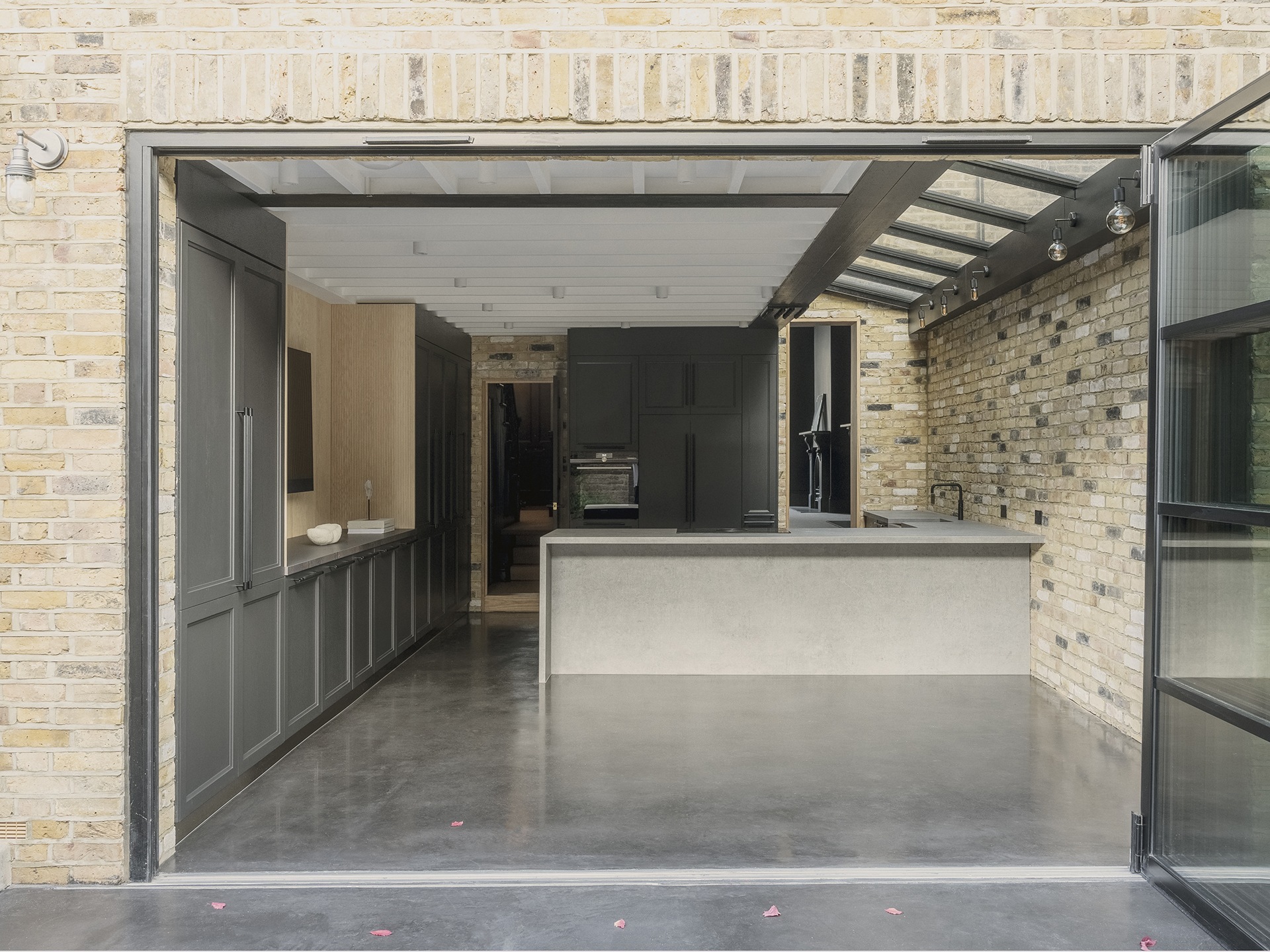
- Dark polished concrete laid by Lazenby runs from inside to out in the @30somethinghome. Image credit: @piercescourf
Whatever finish you want, to create a polished-concrete floor, about 100mm of strong concrete needs to be poured directly over the insulation, underfloor heating and reinforcement.
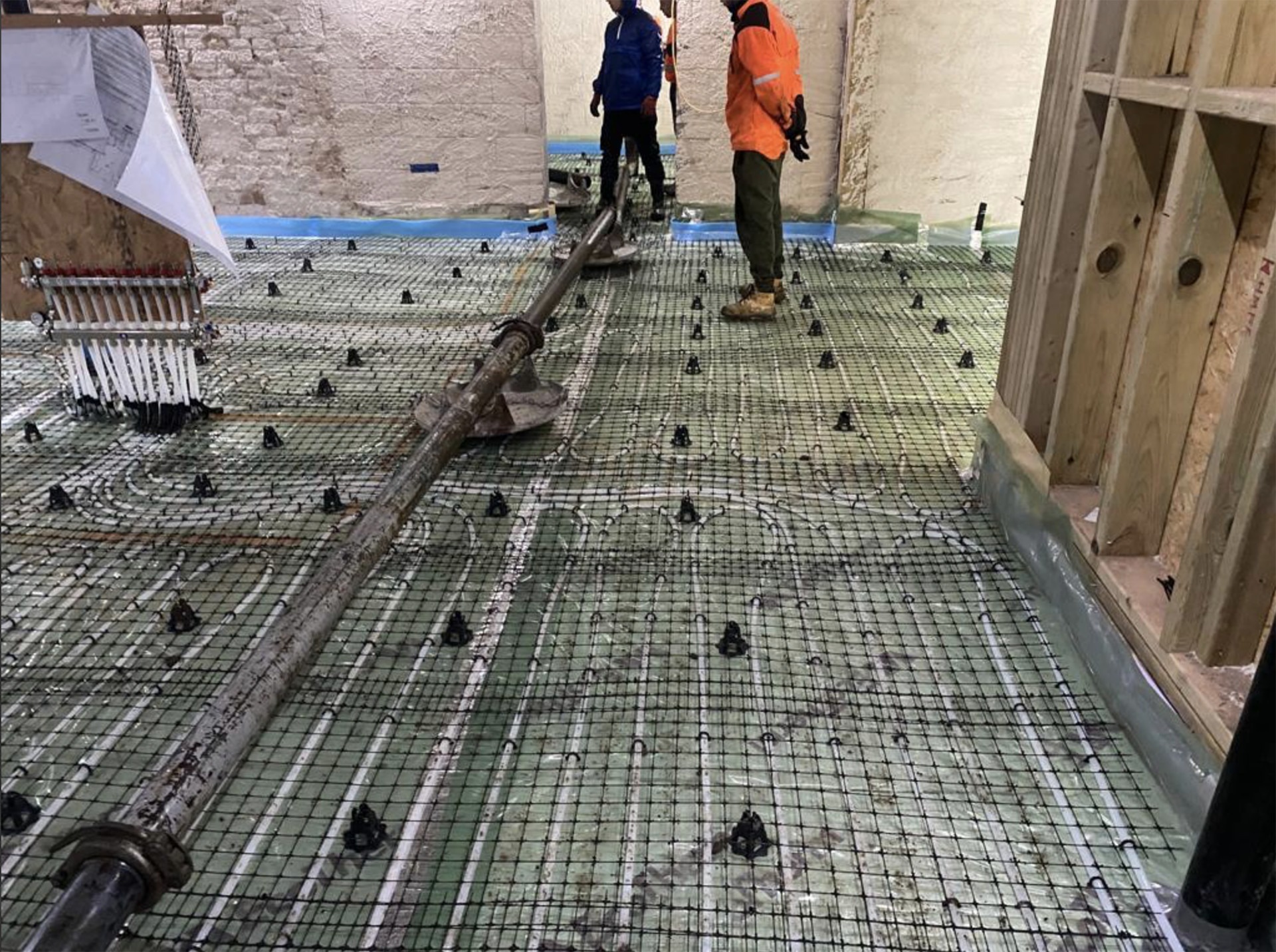
- Work in progress by Concrete Polishing UK
Cream concrete
Cream polished concrete has the look many people picture when they think of polished concrete: a distinctive ‘cloudy’ appearance on its surface and no exposed aggregate. It isn’t actually ground down using concrete-grinding machines, rather, it is smoothed when wet using mechanical smoothing tools called power trowels, in what is a highly skilled, specialist operation. The cloudy appearance is made of patterns in the sand and cement formed by the circular movements of the power trowels as they smooth the concrete’s surface.
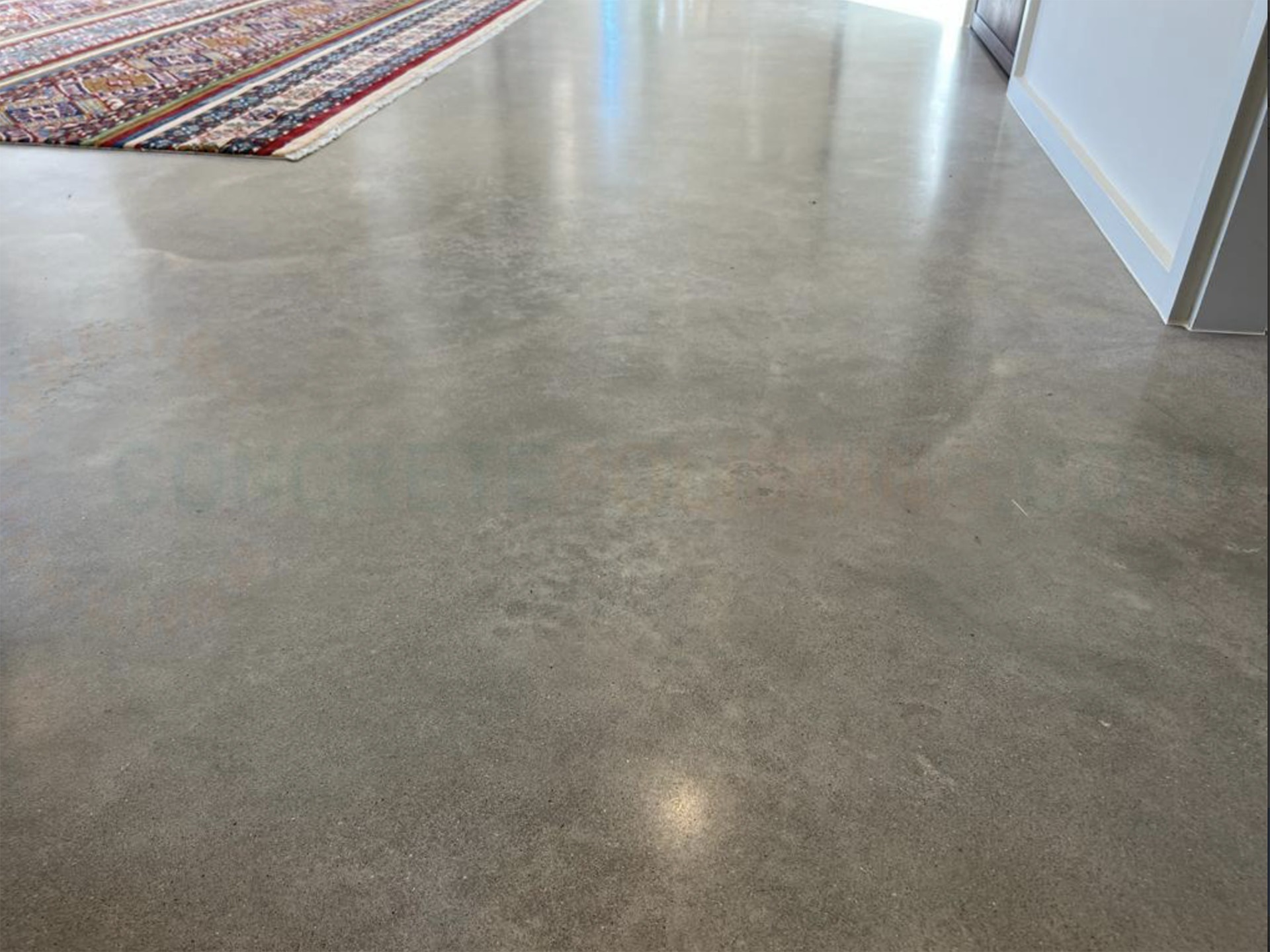
- The characteristic pattern of cream polished concrete laid by Concrete Polishing UK
A cream floor can only be installed in a space where there is room to use power trowels or the larger industrial ride-on concrete smoothers. And not all concrete suppliers will be able to deliver this finish. It’s a job for specialists; some of whom can install cream concrete outside as well, to achieve a seamless indoor–outdoor look. Once it is cured (set), the smoothed concrete is burnished then sealed with densifier and sealant to give a matte, satin, or gloss finish. Only the right cement, finished in the right way – ie with the skilled use of power trowels – can give this exact look.
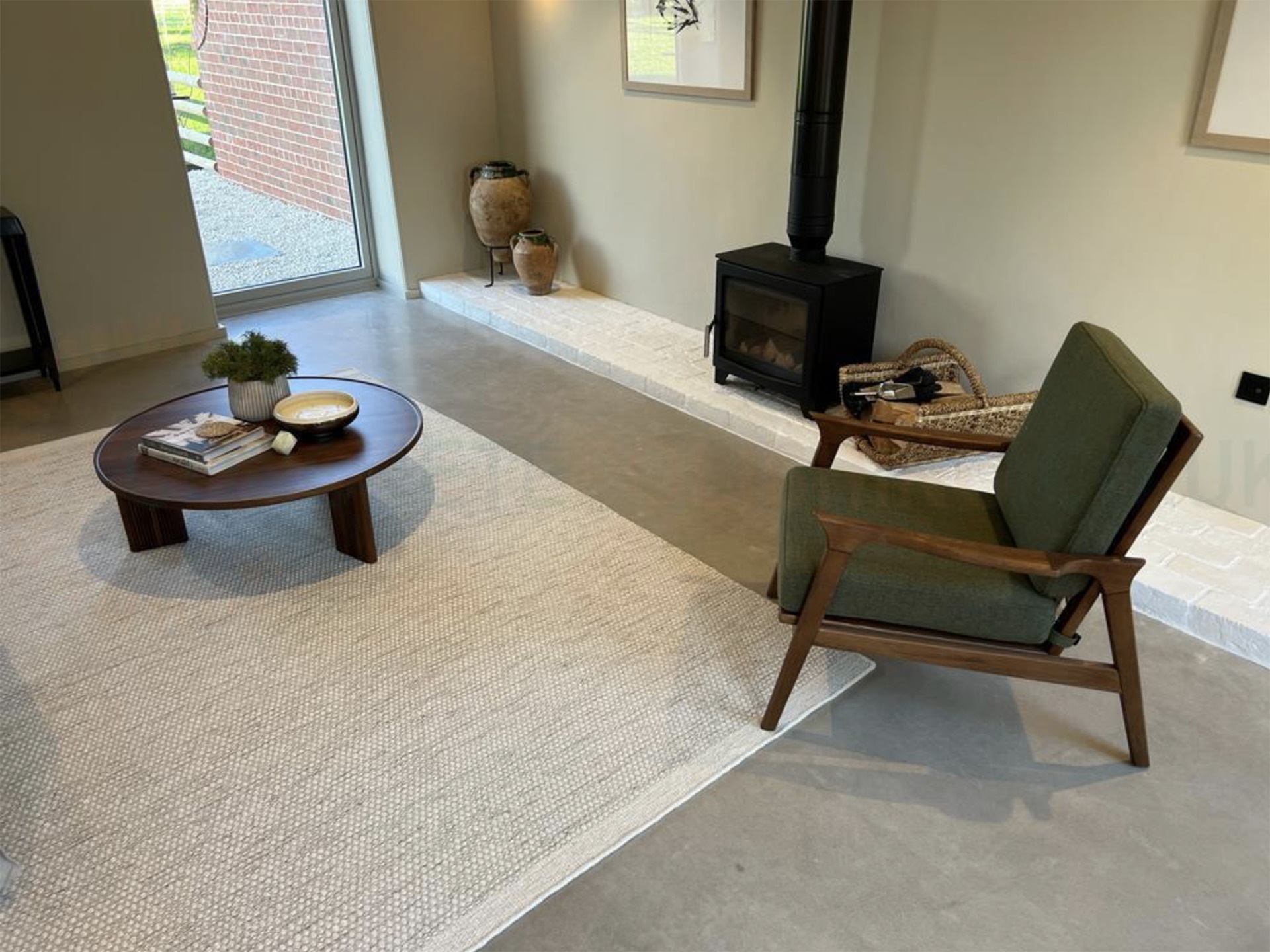
- This understated finish from Concrete Polishing UK is the perfect foil for the mid-Century pieces in this interior
Salt-and-pepper finish
If the concrete surface is polished down with an abrasive diamond concrete-grinder, so the small stones in the cement (the aggregate) just begin to show, you get a slightly speckled look. This medium level of grind – taking approx 1mm from the surface – creates what is known as a salt-and-pepper finish.
Again, ideally, the concrete will need to be specified or supplied by the polishing company and smoothed with power trowels. So you need to get the specialists involved early on. This type of floor should be slightly cheaper than a fully-ground floor (see below) because it requires less grinding.
Full grind
If you want a stronger look, you may want to consider a fully-ground diamond-polished floor, in which more of the surface of the concrete is ground down to reveal more of the aggregate, giving a striking terrazzo-esque look. The exact look will, of course, depend on what the aggregate is. So prescribing what aggregate is used can give you some control over the final look of the floor.
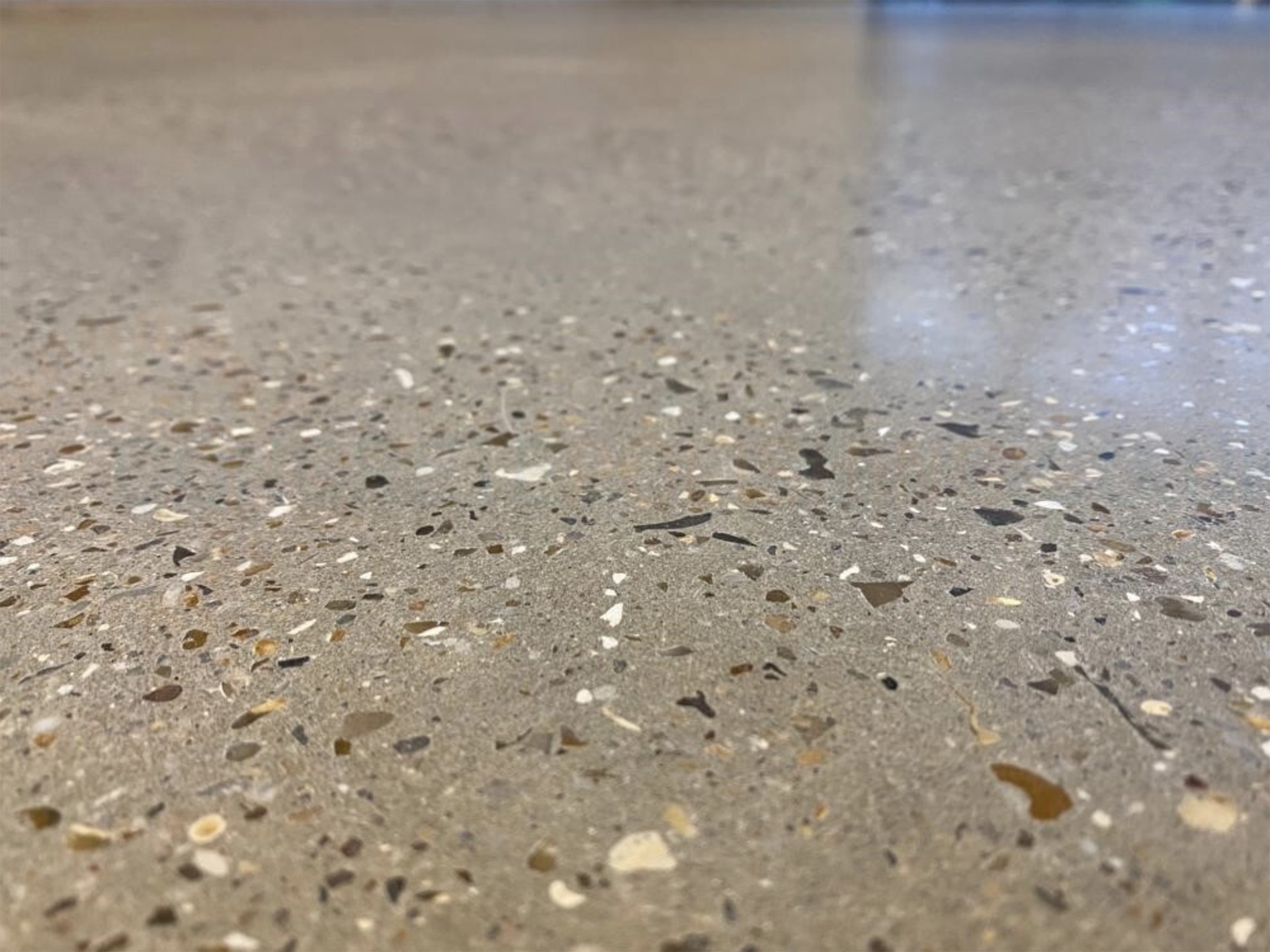
- The more the concrete is ground down, the more aggregate is revealed. Concrete Polishing UK
A full-grind diamond polish can also be a way to polish up an existing concrete floor or recover a floor that hasn’t been smoothed well enough to achieve a cream finish. Or it can be a deliberate choice for someone who wants to make more of a feature of their floor. The final level of shine on the floor is determined by the level of polishing.
Densifiers
The untreated surface of concrete contains lots of tiny holes created by air pockets. This makes it porous and prone to staining. Raw concrete also gives off lots of dust. To solve these problems and make the surface of the floor stronger, the polished concrete is coated with something called a densifier. This is usually a silicate, a glass-like liquid that penetrates a few millimetres into the concrete and hardens. It helps protect the concrete from chips and stains.

- Stunning light-coloured floor in the kitchen of Verus Construction’s Sandmore Avenue project
Different densifiers have different qualities: some produce a shinier finish; some are stronger; some can bear re-buffing more times; some can be buffed immediately after they are applied. Talk to your contractor about what type best suits your project.
In some situations, such as workshops or garages, a densifier is all that is needed. But in most residential setting, a sealant is also applied to give the floor additional protection.
Sealants
Sealants protect the floor from staining. They can be made from acrylic, epoxy or urethane, and can be solvent- or water-based. The water-based options are the low- and no-VOC (volatile organic compound) choices. If you are not sure whether your floor has a damp-proof membrane beneath it, or aren’t 100% sure that your concrete is 100% cured, it would make sense to choose a breathable sealant. Sealants will last several years and can be reapplied.
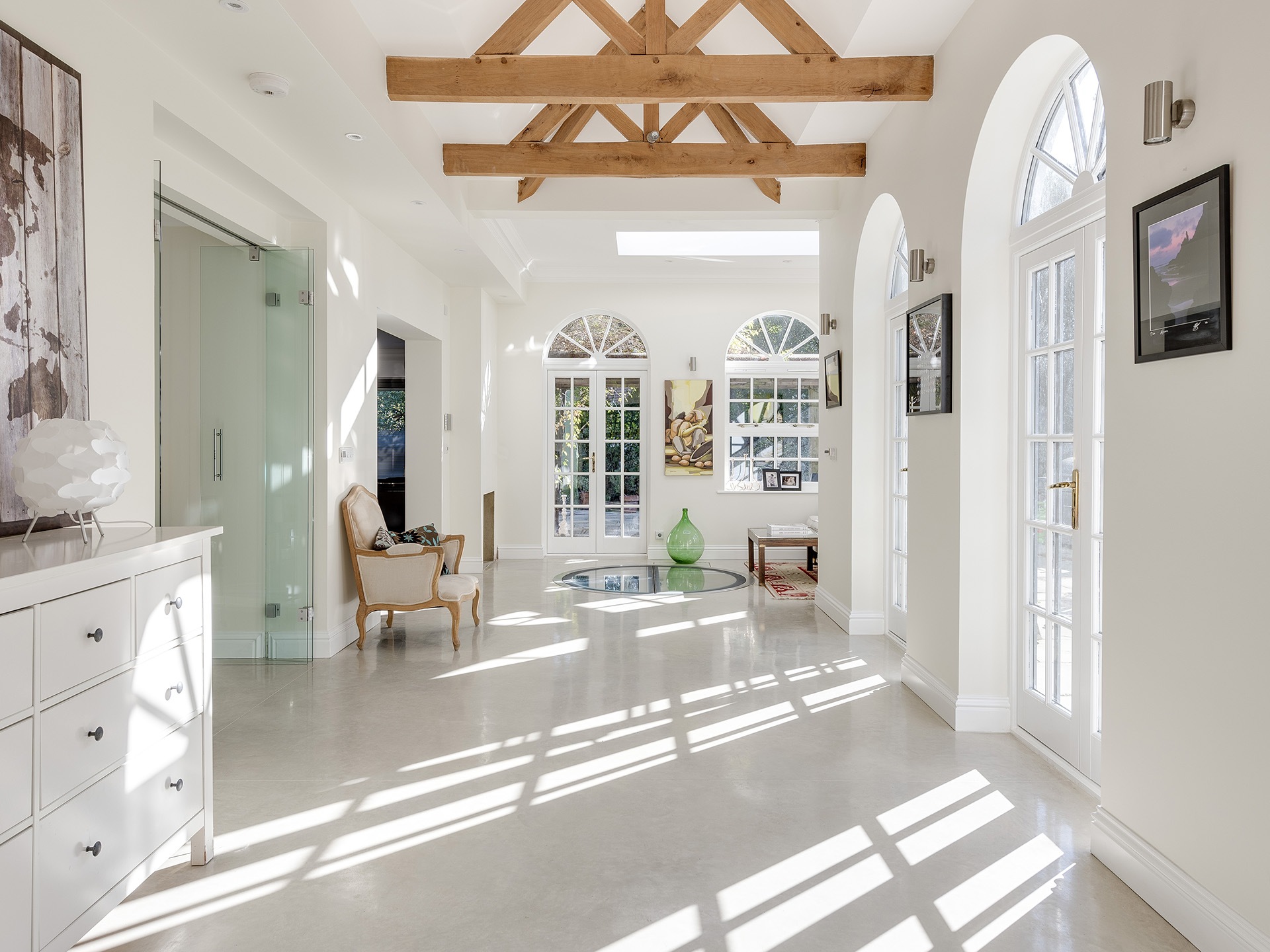
- Lighter coloured concretes are increasingly popular. Image credit: Lazenby
Get expert advice early
Some polished-concrete companies lay the concrete for you themselves. Others give you a spec for the mix and how it should be laid, then come in and grind and treat it after it has cured. Whichever approach is taken, you need to get them involved as early as possible.
There will need to be at least a month between the laying of the concrete and its polishing, while it cures (sets). During this time the concrete can be covered up and other trades can go about their business on top of it.
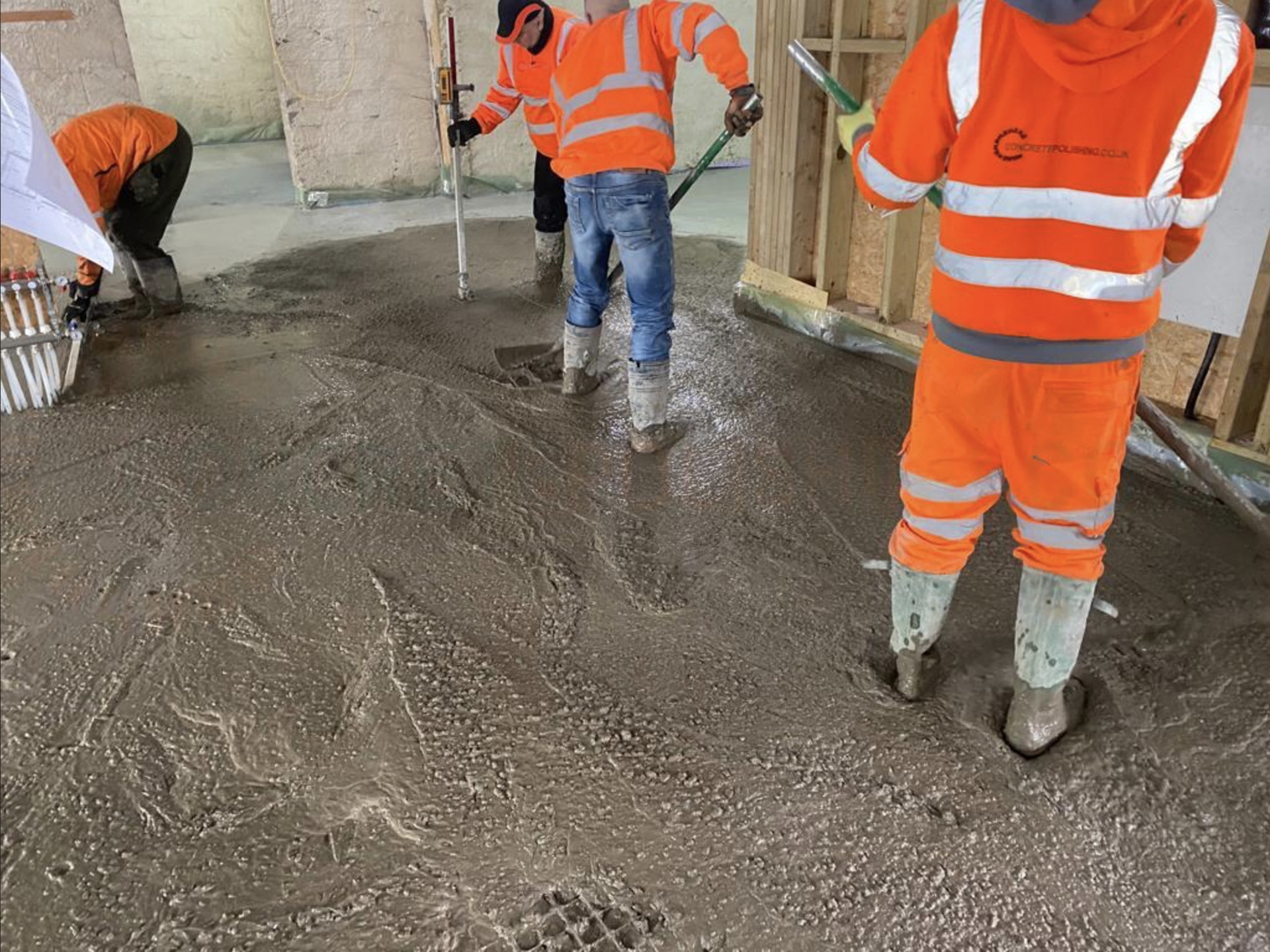
- Concrete being poured by Concrete Polishing UK
Existing concrete
Existing concrete floors can be polished, but, whether you can polish any particular floor, depends entirely on its strength and condition. And the finished look will depend on what kind of concrete it is and what aggregate it was made with. Damaged areas will need to be repaired and it can be hard to match the existing concrete. So some people choose a contrasting cement for the repairs and make a feature of them.

- Image credit: Lazenby
Microcement
In some situations not suited to a new polished-concrete floor – perhaps where there is already an existing floor that is not of high enough quality to be polished, or, if there isn’t enough time to allow for the curing process – you can choose a microcement (also known as microtopping or concrete overlay) product instead. This is a thin layer of cement powder and resin used to create a polished-concrete look.
Microcement can work well if you want to take a surface from the interior to the exterior. It is good for getting the concrete look on vertical surfaces, and in places, such as ensuite bathrooms or high-rise flats, where real concrete would be too heavy. Microcement also works well in areas that get wet regularly, such as bathrooms. Polished-concrete specialists usually also offer microcement products and installation.
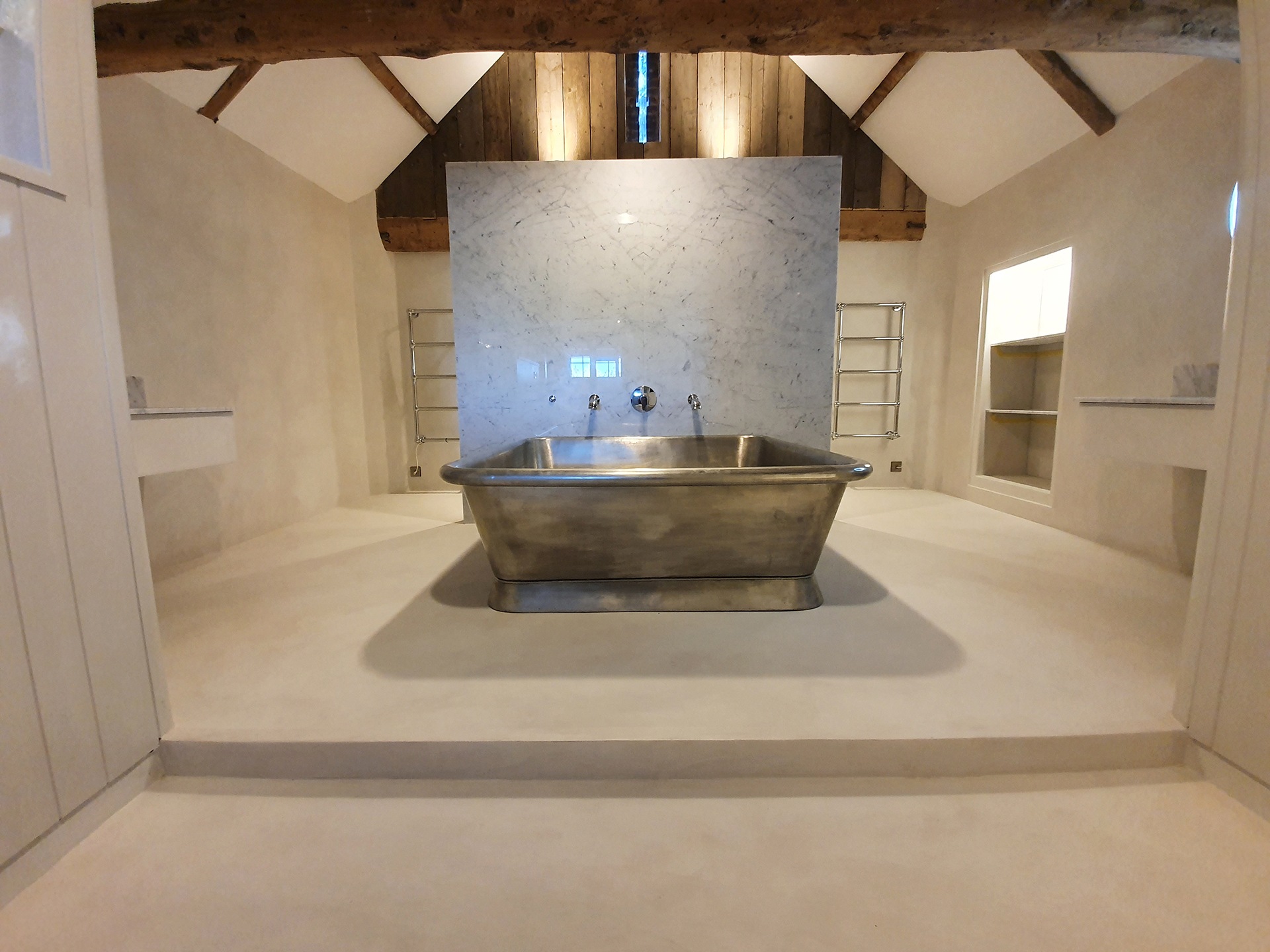
- Microcement can be used to give the look in situations not suitable for ‘real’ polished concrete. Image credit: Lazenby
Durability
Polished concrete is a tough, hard-wearing floor, which is why it is used in factories and retail spaces. The densifier and sealant increase its strength, but it can still be chipped and cracked if you drop something heavy on it.
When the concrete is being laid, expansion channels need to be cut into the slab every few metres and filled with matching flexible sealant such as silicone. The aim of these is to avoid cracks elsewhere in the floor.
Does it work with underfloor heating?
Wet-system underfloor heating works really well with polished concrete. Concrete stores heat well and releases it slowly, and a concrete floor with underfloor heating feels really nice to walk on. However, sudden big changes in temperature in the underfloor system can lead to cracks in the concrete.
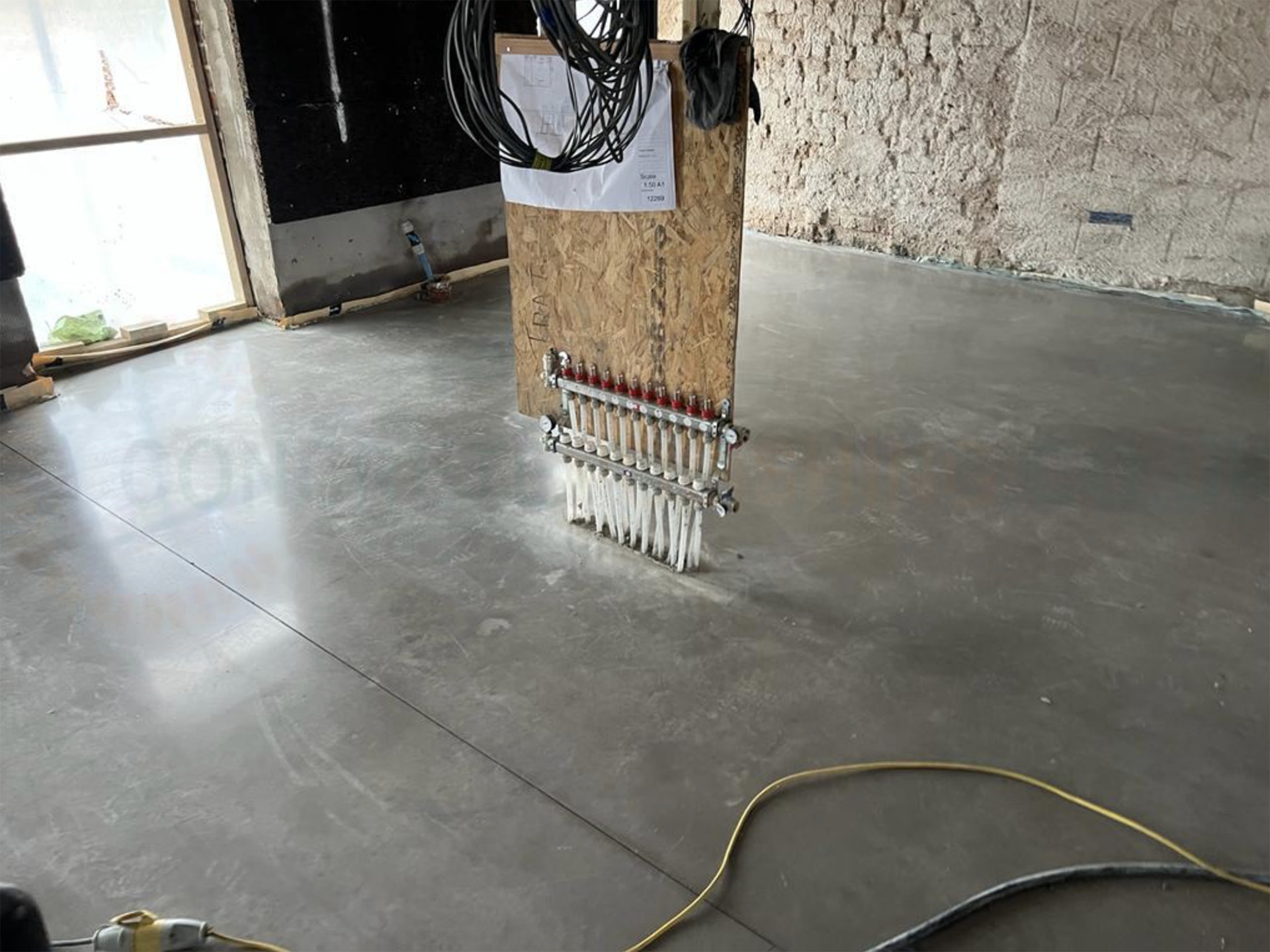
- Underfloor heating installation by Concrete Polishing UK
Does it get slippery?
Concrete is less slippery than you might expect, but if you install polished concrete somewhere where it will get wet, ask your contractor about applying a non-slip coating.
Colours
Raw concrete varies in colour depending on the materials used to make it: the main colour of a concrete is determined by the colour of the sand it is made with. If you are grinding down a concrete to reveal aggregate, the colour of the aggregate will, of course, have a big impact on the final colour of the floor. You can choose to use a special decorative aggregate in your concrete to create a terrazzo-style effect.
There are all kinds of additives and stains available today to give different coloured concrete. It can be coloured with pigments added to the mix or scattered over the surface and worked in as it is power-trowelled. Or dyes can be applied to the surface. These can also be used on existing concrete floors. Water-based, as opposed to solvent-based formulae, are available. Microcement comes in an even wider range of colours.
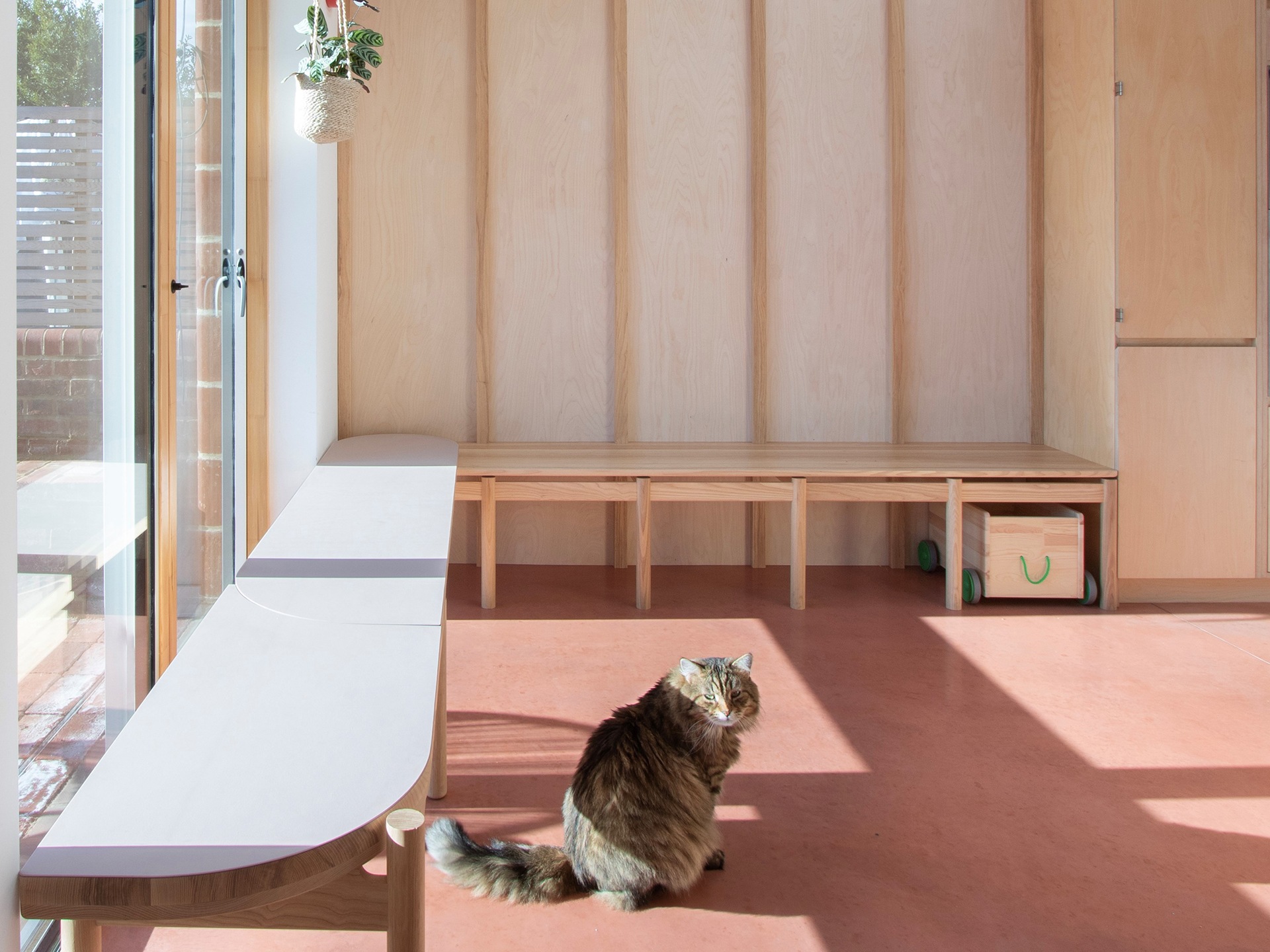
- A wide range of coloured concretes is now possible, such as this warm red tone from Lazenby
Lighter shades can bring so much reflected light into an interior, while red-brown shades offer a warmth lacking in traditional grey concrete. Ben Young, from polished-concrete specialists Lazenby, says. “Recently, people have been opting for warmer, lighter colours, as opposed to the mid-greys that were traditionally very popular. Our Buff and Oyster White colours, which have warm undertones, have been our most popular during the last two years.”
Looks
Polished concrete on the floor can be matched with microcement on walls to create an enveloping concrete environment. The resulting minimalist space makes a wonderful, neutral backdrop for colourful art works, luxurious textiles and luxe furniture, as well as the perfect environment for mid-century pieces. Some polished-concrete specialists, such as Lazenby, offer built-in, cast-in situ and pre-cast concrete furniture, such as benches, countertops, sinks and stairs, to create a completely seamless look.
Maintenance
You need to keep your polished-concrete floors clean because grit and dirt will scratch the surface quite easily. A brush down with a dry mop daily and a weekly damp mop using pH-neutral cleaner should prevent problems. You must clean up all spills promptly to avoid stains, and avoid caustic or abrasive cleaners. To keep your floor in tip-top condition, you can also use a floor-maintainer product. Christian Roberts, flooring expert at MyJobQuote.co.uk, advises, “Don’t assume a polished-concrete floor is 100% waterproof. The densifier chemicals and sealants act as water repellants, but, as a naturally porous material, concrete is not completely waterproof even with these additions. Despite its durability, concrete is not impervious to damage. A polished-concrete floor can be scratched, so avoid dragging heavy furniture across its surface. Put boundary mats by doors from the outside to help remove small stones and grit from shoe soles and prevent scratching.”
Polished concrete is perceived to be a hygienic choice as it offers no haven for dust mites and allergens, and is relatively easy to clean.

- Microcements, like Lazenby’s MicroLux, can be applied to all kinds of surfaces to give a polished-concrete-style look
Sustainability
Polished concrete is also a sustainable choice because it replaces screed, concrete floor and floor covering. Polishing an existing concrete floor is also a great way to reduce the carbon footprint of a refurb project. Polished concrete is usually a low-VOC choice too. For all these reasons, polished-concrete floors can contribute to LEED (Leadership in Energy and Environmental Design) certification. Microcement can be an even lower-carbon choice. Or you can ask your contractor about using blended cement and locally-sourced aggregate. When your concrete floor reaches the end of its life, it can be reused as hardcore or aggregate.
How much does it cost?
Christian Roberts says, “The cost of a polished-concrete floor will be around £130-£160 per square metre, which is about the same as you would pay for high-end natural-stone tiling. The size of the room, the type of style you want and whether you have colour added will all add to the overall cost.” This may seem quite expensive, but remember it means you don’t need to pour a separate screed. Nor will you need to buy and lay tiles. Or laminate, vinyl or carpet. The cost for just polishing/grinding concrete will be between £30-£50m2 depending on the finish required, the quality of the concrete, the amount of edges that are included in the area, and whether any repairs are required.

- Striking black concrete by Lazenby in @30somethinghome Image credit: @piercescourf
Choosing the right contractor
Polishing concrete is a skilled job not something suited to tackle as a DIY project. Martin Clark advises, “When choosing a contractor, view some of their previous work and do look at polished concrete in the flesh, as opposed to seeing in a magazine or online. Polished concrete has lots of variation in appearance and characteristics. So it’s important you know what to expect. Polished-concrete floors are not uniform in appearance, and they are created using industrial methods. Choose a contractor who is experienced in polished concrete, especially in residential properties, because these require a high level of detail, workmanship, and technique.”
Choosing the right contractor is vital to getting great results. Talk to a specialist company at the beginning of your project rather than waiting until your slab has been laid, at which point your options may be limited by the quality of the pour and the concrete. Polishing is a labour intensive, expensive business, and results are dictated by the quality of the concrete. It is cheaper to get it right from the start: so talk to the experts early on.
Why I chose polished concrete
David O’Brien told us why he opted for polished concrete in his beautiful contemporary self-build home in Munster, Ireland, The Black House, “I chose polished-concrete floors for the entire ground floor of my home because I love the contemporary look. Matched along with white walls it creates a neutral palette that goes with everything. I have an eclectic mix of furniture in my home that dates from the 16th Century right up to the modern day, and I feel the polished concrete help all these pieces to shine and sit in harmony together.

- Image credit: The Black House and Hillary’s Blinds
“Some of the other benefits include durability and how easy it is to clean. One thing to note is that certain liquids can stain – red wine, oils etc – but I think this adds character.
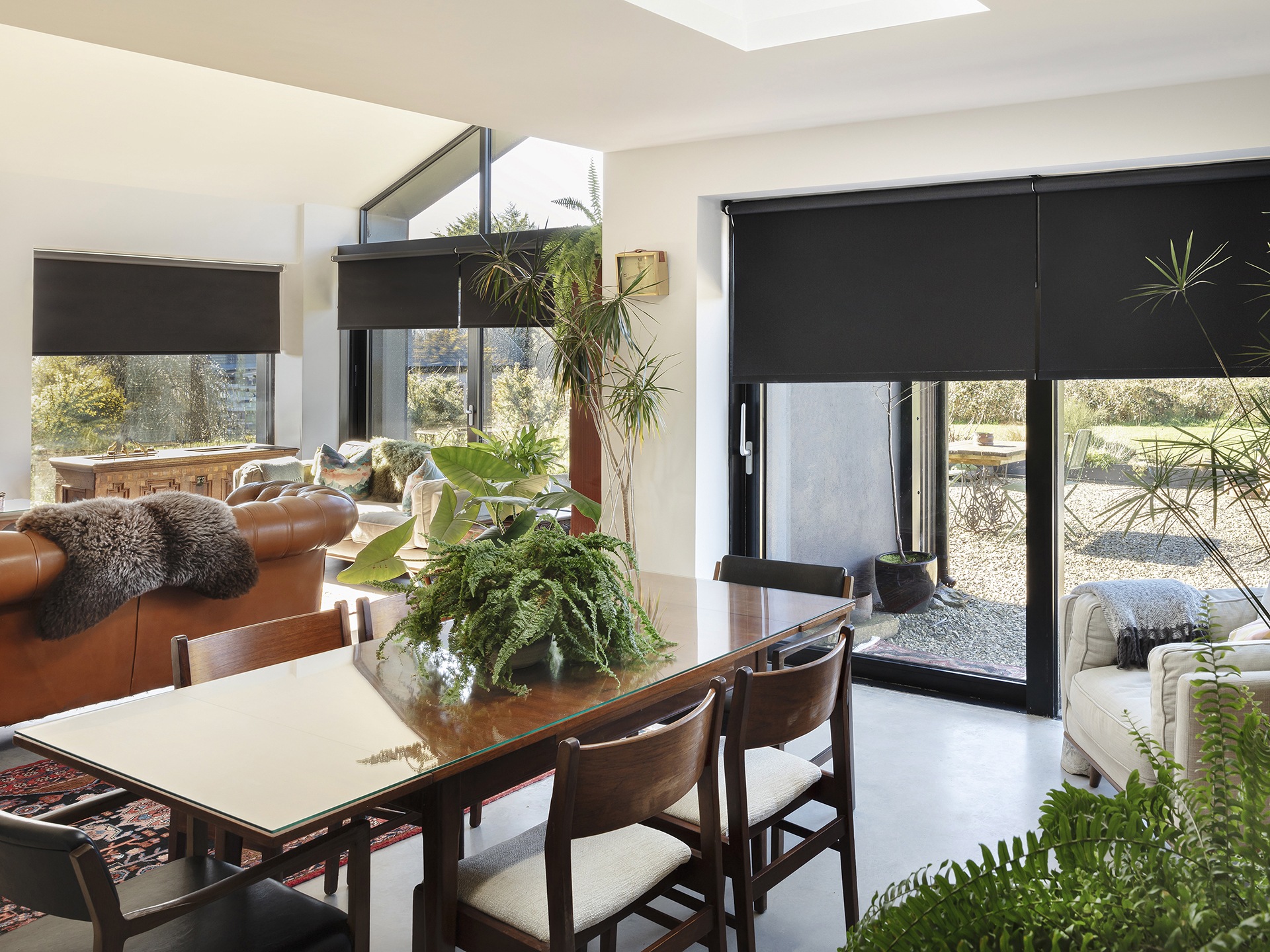
- Image credit: The Black House and Hillary’s Blinds
“To further enhance the light and space, I incorporated large windows throughout the ground floor. This floods the rooms with natural light, which beautifully reflects off the polished concrete. To balance the coolness of the concrete and white walls, I installed black electric blinds. The blinds add a touch of drama and perfectly offset the contemporary feel of the polished floors.”

